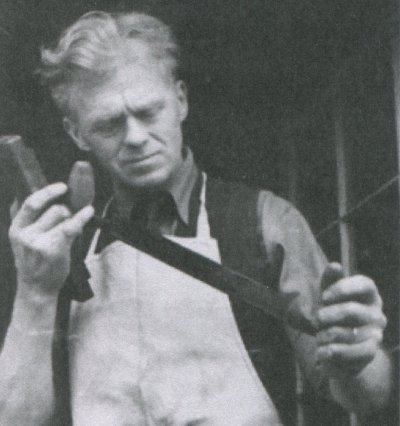TrustNews Jun 20
Trust visit to The Edward Barnsley Workshop
On a sunny but chilly morning on Friday 13th March - just a week before the Covid-19 lockdown began and no-one was allowed to go anywhere - a lucky bunch of Trust members convened beside a back road in Froxfield, near Petersfield. They (we) were there to visit the Edward Barnsley workshop, and we were particularly lucky as the trip was oversubscribed. Some members were politely asked if they wouldn‘t mind deferring their visit until a second one could be arranged, probably some time in May. You can fill in the rest of that story.
Edward Barnsley was born in 1900, the son of Sidney Barnsley and nephew of Ernest, who were both master builders and furniture makers, significant figures in the Arts and Crafts movement. Simon Jenkins, in England’s Thousand Best Churches, describes Sidney's church of St. Sophia (now the Church of Jesus Christ and the Wisdom of God) in Tadworth, Surrey, as a neo-Byzantine treasure house. It is listed Grade l.

Edward Barnsley, 1945
Edward was sent to Bedales school, down the road from Froxfield, and never quite left. In 1922 he worked with Ernest Gimson (with whom his father and uncle had worked before) on the Lupton Memorial Library at the school; that is now also listed Grade l. Pevsner described Gimson as ‘the greatest of the English artist-craftsmen’. So the young Barnsley was taught by the very best masters.

Bedales library 1921, Barnsley's training ground
He established his workshop in a modest series of buildings on a sharp escarpment, in 1923, and continued to work until his death 1987. During his lifetime, in 1980, the Edward Barnsley Educational Trust was founded, to continue his work, in the recognition that small craft workshops can not usually afford to offer apprenticeships. James Ryan, the workshop manager and the man who showed us around, began as an apprentice there in 1992. He was recently awarded a Master Furniture Maker Certificate by the Worshipful Company of Furniture Makers.

The wrkshop c. 1936
The apprentices stay for up to three years, at the end of which they are capable of the extraordinary work the organisation produces. James showed how they begin with a simple piece of work, bookends or a candlestick, graduating next to a small wall-hung cabinet using different woods and techniques. Even the brass lock is made by the apprentice. All the young workers we saw on our visit were male; we enquired whether they ever had any female apprentices. The answer was, ‘very few’. In fact the Workshop brochure we were given lists all the apprentices since 1981, and their subsequent place of work. Some continue to be makers, others designers or teachers. There is just one woman, Laura Tunstall, in 2011, who went on to design for Luke Hughes & Co., who say they ‘design and engineer furniture in architecture’ - a pretty good description of the Arts and Crafts approach. James said they would like to have more women apprentices - it’s hard to say what might be deterring them.

James Ryan with a set of library steps - and apprentice pieces in the background
The old workshops were proving insufficient, so the Foundation was able to acquire from the landowner over the road enough land for timber storage and drying sheds. One of the sheds is Barnsley’s original, relocated, the other a fine new copy. The land on which the shed originally stood is being developed for improved workshops.
Each piece of timber is named and labelled. For me the most striking thing we saw was an enormous slice of oak, about 2.5m x 1.5m, complete with bark and burrs. James had yet to decide what to do with it. The table tops he designs are vastly more sophisticated, with patterned inlays and fine veneers, but a table of this slab would be in the early tradition of the master.

From a simple Stool to the immensely sophisticated Repose Mk1 rocking chair
We saw a number of pieces that were being prepared to be shown at Masterpiece London, in June. inevitably that has been cancelled. The workshop is closed and James is principally concerned about the apprentices and the interruption to their training. But this is a wonderful traditional enterprise that has grown successfully into the 21st century, and - as long as people and institutions value the unique and handmade - will surely continue to flourish.
After leaving the workshop we called in at All Saints Church in the village, to be shown the organ case that was made by Barnsley - described in Pevsner as ‘excellent’. Also in the delightful and venerable church, dating from around 1140, is a double memorial window to the poet Edward Thomas, engraved by Laurence Whistler and installed in 1978. Thomas lived in Steep between 1906 and 1916. Shockingly one of the windows was broken in an attempted burglary in 2010 - hard to imagine in this peaceful setting. When the replica was installed three years later, it was dedicated by the former Archbishop of Canterbury, Dr Rowan Williams.
The visit concluded with a substantial pub lunch at The Harrow, finding which is an adventure in itself. Picturesque and agreeably eccentric - no credit cards, always fresh flowers for sale outside for local charities - its building dates back to the 18th century. CAMRA includes it in its list of ‘Britain's best real heritage pubs’- highly appropriate and very welcome after our slightly chilly morning.
Judith Martin
Picture of logo and oak slab kindly sent by James Ryan; all other photos from the Edward Barnsley Workshop Annual Review, 2018, except Bedales Library, posted by Bedales on Wikimedia Commons (CC BY-SA 4.0)
